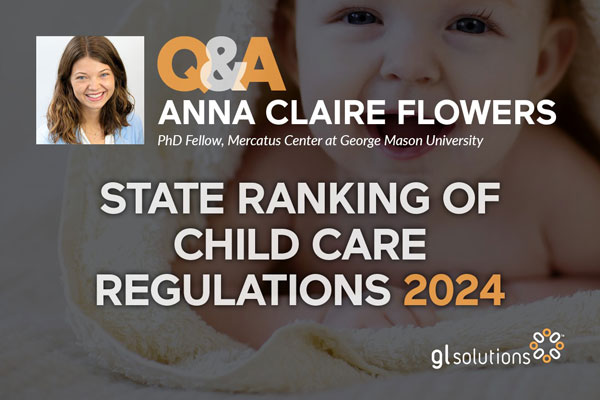Discover How Your State Ranks
Find out how your state ranks in the first edition of the Childcare Regulation Index. We interview Anna Claire Flowers, PhD Fellow, Mercatus Center at George Mason University, and co-author of the Childcare Regulation Index in the States: 1st Edition from the Knee Regulatory Research Center. She breaks down the key takeaways from the report, specifically the impact of child care regulations on child care costs, state fertility rates, as well as family goals.
The first edition of the Childcare Regulation Index ranks child care regulations in the states from least restrictive to most restrictive. In the report, for example, Louisiana ranks first, as the least restrictive, while Massachusetts ranks last, as the most restrictive. In addition to a numbered rank, the research also places each state in one of four “quartiles,” color coding them from least to most restrictive on a U.S. map.
“The general finding from our working paper on comparing these two metrics,” says Flowers, “is just that as you have more restrictive child care regulation, we do see a correlation with higher fertility gaps. So maybe another way to say that—it’s just harder to achieve fertility goals, or family goals, in those states. And child care is possibly part of that.”
Listen to the entire interview with Anna Claire Flowers on our Talkin’ SaaS podcast.

Source: Knee Regulatory Research Center
Q&A with Anna Claire Flowers
In our interview with report co-author, Anna Claire Flowers, we learn the basics about the report—from how states receive their scoring to the key takeaways for regulatory agencies.
According to Flowers, they based the index on four areas of regulation, common to all the states: group size, staff-child ratios, educational requirements and required training.
GL Solutions: How do child care regulations impact state fertility rates?
Anna Claire Flowers: We have this really interesting metric called the fertility gap, which is people’s stated fertility desires and goals. There’s a lot of variation in that measure, too, across the states. Clara Piano and Lyman Stone, who are on the team, have already established there is a relationship between economic freedom generally, and lower fertility gaps. So, you can say people are able to achieve their family goals a little bit easier. And that could look like: I was able to start my own business, or I was able to find a family daycare home in my neighborhood because they weren’t moved out of the neighborhood by zoning or different licensing requirements. It could be a million different things. But this general economic freedom seems to just be correlated with people achieving those family goals a little bit easier.
We wanted to sort of zoom in and say, okay, child care regulation seems even more relevant to those family decisions. And I think it’s not just that costs go up, which Gory and Thomas 2017 have a great paper on that we’re building on.
GL Solutions: Would you explain the state and regional rankings?
Anna Claire Flowers: The general finding from our working paper comparing these two metrics is just that as you have more restrictive child care regulations, we see a correlation with higher fertility gaps. So maybe another way to say that—it’s just harder to achieve fertility goals, or family goals in those states, and child care is possibly part of that.
In the northeast, I’m still grappling with these findings. I think there is sort of this perceived cost of having kids. So perceived like, you have to be at a certain level of financial security. You have to be able to give them the world. And everyone wants to, obviously. But kind of this really, really high standard for where you have to be in life, and your financial situation and that kind of thing, to be able to even justifiably start a family.
And I think those cultural things are really different everywhere. And we’re seeing that reflected in the child care regulations. I mean, I think it really does correlate with people’s perceptions of what the minimum quality is for any kind of child program.
And then, you know, we’re just seeing sort of the cluster up in the Northeast. And then, California and Oregon also have above average fertility gaps. And so, we’re not saying it’s all child care regulation. But I do think about the effect that the regulations have on those perceived (costs). I think it’s a big piece of the puzzle where you look at the options and you say: is this doable?
GL Solutions: Is there a correlation between higher regulations and higher quality child care?
Anna Claire Flowers: One of the things that seems to have the most quality impact are the training hours or training requirements. And if you think about it intuitively, it makes sense, regardless of someone’s educational level. There’s this whole range from GED, or not even GED, up to a bachelor’s degree in early childhood education. So much of child care and the quality is the way people interact with the kids. But in essence, you could have an early childhood education degree theoretically, and still not have that tenderness that’s required.
GL Solutions: What stood out to you about this index?
Anna Claire Flowers: I think one of the main things that’s been interesting to me is looking into those minimum educational requirements and thinking about that again. It ranges all the way from less than a GED to a bachelor’s degree in early childhood education. And I think there’s a lot there that isn’t captured in an educational background. I think that stands out to me the most. Maybe if the parents themselves aren’t educated in this way, they might not really care to pay for someone who has a bachelor’s degree in early childhood education. You know, they’re just trying to work a job. I just think about how people have very different values and experiences when it comes to what education represents and what it means, especially when it comes to child care.
Editor’s note: Answers edited for clarity and brevity. To hear the entire interview, listen to our interview with Anna Claire Flowers on our Talkin’ SaaS podcast.
About GL Solutions
GL Solutions celebrates over 25 years of helping state regulatory agencies, including child care agencies, better serve the public with their licensing and permitting software, GL Suite. GL Suite transforms and digitizes operations for scores of agencies and departments nationwide; state agencies from Alaska to Connecticut use GL Suite to improve processes and outcomes.
GL Solutions brings you in-depth reporting on the challenges facing regulatory agencies and the solutions that empower agencies to transform operations and modernize services. Join our mailing list to receive the latest news and solutions for regulatory agencies.
Time to Modernize
GL Solutions helps your regulatory agency run, grow and adapt through modern software and automation that helps solve your agency’s greatest challenges. To learn more, contact us.
To receive the latest regulatory news delivered to your inbox each week, subscribe to our newsletter.



